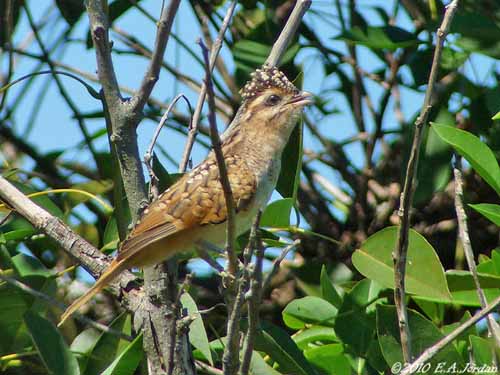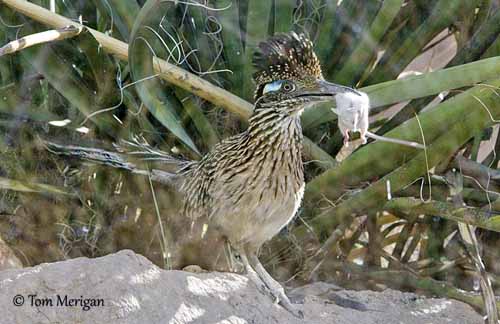
Photographers :
Tom Grey
Tom Grey's Bird Pictures
Patrick Ingremeau
TAMANDUA
Eduardo Andrés Jordan
MIS AVES – AVES DE ARGENTINA
Tom Merigan
Tom Merigan’s Photo Galleries
Philippe et Aline Wolfer
GALERIE
Text by Nicole Bouglouan
Sources :
HANDBOOK OF THE BIRDS OF THE WORLD vol 4 by Josep del Hoyo-Andrew Elliott-Jordi Sargatal - Lynx Edicions - ISBN: 8487334229
L’ENCYCLOPEDIE MONDIALE DES OISEAUX - Dr Christopher M. Perrins - BORDAS - ISBN: 2040185607
BirdLife International (BirdLife International)
CREAGUS@Monterey Bay (Don Roberson)
Wikipedia, the free encyclopaedia
CUCULIDAE FAMILY
Subfamily Neomorphinae
The subfamily Neomorphinae includes the New World ground-cuckoos. There are ten species gathered in five genera: Tapera, Dromococcyx, Morococcyx, Geococcyx and Neomorphus.
These long-legged and long-tailed cuckoos have variable breeding habits. Three of them are brood-parasitic species, the Striped Cuckoo (Tapera naevia), and the two species of genus Dromococcyx, the Pheasant Cuckoo (Dromococcyx phasianellus) and the Pavonine Cuckoo (Dromococcyx pavoninus).
These three species occur in South America and Central America, except the Pavonine Cuckoo which is only present in NE South America.

Striped Cuckoo
Tapera naevia
The other species are nest-building, non-parasitic cuckoos. The roadrunners of semi-arid regions of North and Central America are mainly lizard-catching birds.
The roadrunners run at speeds of up to 30km/hour, and can cover considerable distances on the ground while pursuing their preys, lizards, grasshoppers and small mammals.


On the other hand, the large forest species of South America often follow swarms of army-ants. These species belong to the genus Neomorphus. They are uncommon to rare, and the Banded Ground-Cuckoo (Neomorphus radiolosus) is evaluated as Endangered due to forest destruction.
These ground-cuckoos (Length: 50 cm) frequent forested and wooded areas. The Neomorphus species mainly depend on tropical lowland evergreen forest and forest in highlands. They are visible from lowlands to 700/1500 metres of elevation. They are found in small areas in South America.
They feed on large insects, frogs, lizards, spiders, and occasionally fruits and seeds.
They are terrestrial but very agile birds. They often run, and may flutter to high perch. They often forage at swarms of army-ants. They run and bill-snap close to ant raids, forage in the leaf-litter, peck at preys and capture flushed insects by running on the ground.
These birds are solitary and restless. They run fast and perch at mid-level in tree branches.
The unique Morococcyx species has similar feeding behaviour. It occurs in west coast of Central America. This species appears fairly common in its range.
The Geococcyx species (Length: 48-56 cm) are mainly found in arid scrub, lowland or montane. They frequent dry open country with scattered bushes and several cacti species and thorn scrub. They are also found in grassy and wooded hillsides and farmland. They occur from lowland to high elevation, up to 2500/3000 metres.

Geococcyx californianus
They feed on a wide variety of preys such as large insects, spiders, lizards, snakes, small birds and eggs, mice and other small mammals, young rabbits, fallen bats and roadside carrion. They sometimes consume fruits and seeds.
These species are terrestrial and forage alone or in pairs. They usually run, but they can fly too. They hunt mainly on the ground where they run after preys and leap at flying insects. Lizards and snakes are beaten against stones before to be eaten. Scorpions are attacked by the tail. Both mates sometimes co-operate when attacking a snake.

Geococcyx californianus
Both species of genus Dromococcyx frequent tropical lowland forest and seasonally flooded forest and edges. They are visible from sea-level to 1600/1900 metres of elevation.
They feed on large insects and lizards taken from the ground.
The Stripped Cuckoo is the smallest of this subfamily with a length of 26-29 cm. This species frequents the open country with scattered trees, low seasonally wet grasslands, clearing in forest, brush at tropical forest edge and roadsides.
It feeds on large insects and caterpillars, and forages alone on the ground. It often sways from side to side and fans the alula, probably to flush insects.

Striped Cuckoo
Tapera naevia
The Tapera and Dromococcyx species utter melancholy whistled notes.
The Neomorphus perform loud-bill-clapping and utter dove-like moaning “ooooo-oop”, and some varied calls such as loud “kchak” in feeding competition, repeated hoots ‘whou” and roaring hum.
SOME SOUNDS BY XENO-CANTO

Striped Cuckoo
Tapera naevia
During the breeding season, both Greater Roadrunner mates chase each other on the ground, often for several hours, with stops and rest between chases. Wings and tail are fanned and both birds give “clack” calls. The male sometimes utters soft “coo” from elevated perch. It also presents a stick to its mate. But both birds take part in this display. This behaviour usually occurs before the nest-building.
Before the copulation, the roadrunners have a display. The male performs courtship feeding to the female, approaching her in short bursts of speed with food items in the bill and wagging tail back and forth. He runs with lifted wings and tail close to the female, and gradually lowers them. The post-orbital coloured bare skin is exposed and the crest is erected. These displays last more than two minutes.
Another display shows the male wagging the tail from side to side while bowing the head, and then slowly lifting it while giving a “whirr” call in front of the female.
Food is given to the female while they copulate.

Geococcyx californianus
Except the Tapera and Dromococcyx species which parasitize small birds’ nests, and often closed or domed nests, the other Neomorphinae build a nest.
Both roadrunners build an open bulky platform of sticks, lined with leaves, snakeskins and debris. It is placed in bush or low tree.
In Greater Roadrunner, the female lays 2-6 eggs (2-3 in Lesser Roadrunner). The incubation lasts 17-18 days shared by both adults. The young fledge 17-19 days after hatching.

Geococcyx californianus
The breeding behaviour of the Neomorphus species is poorly known. The nest is a broad shallow bowl of sticks, lined with green leaves and placed in dense swampy vegetation.
The roadrunners are fairly common in their habitat. The Striped Cuckoo is variably common to uncommon while the Dromococcyx species are rare and local, as the Neomorphus. All are resident in their range.
They are sensitive to habitat disturbance, land clearance and overgrazing which destroys the low vegetation, and some species have restricted range.

Striped Cuckoo
Tapera naevia